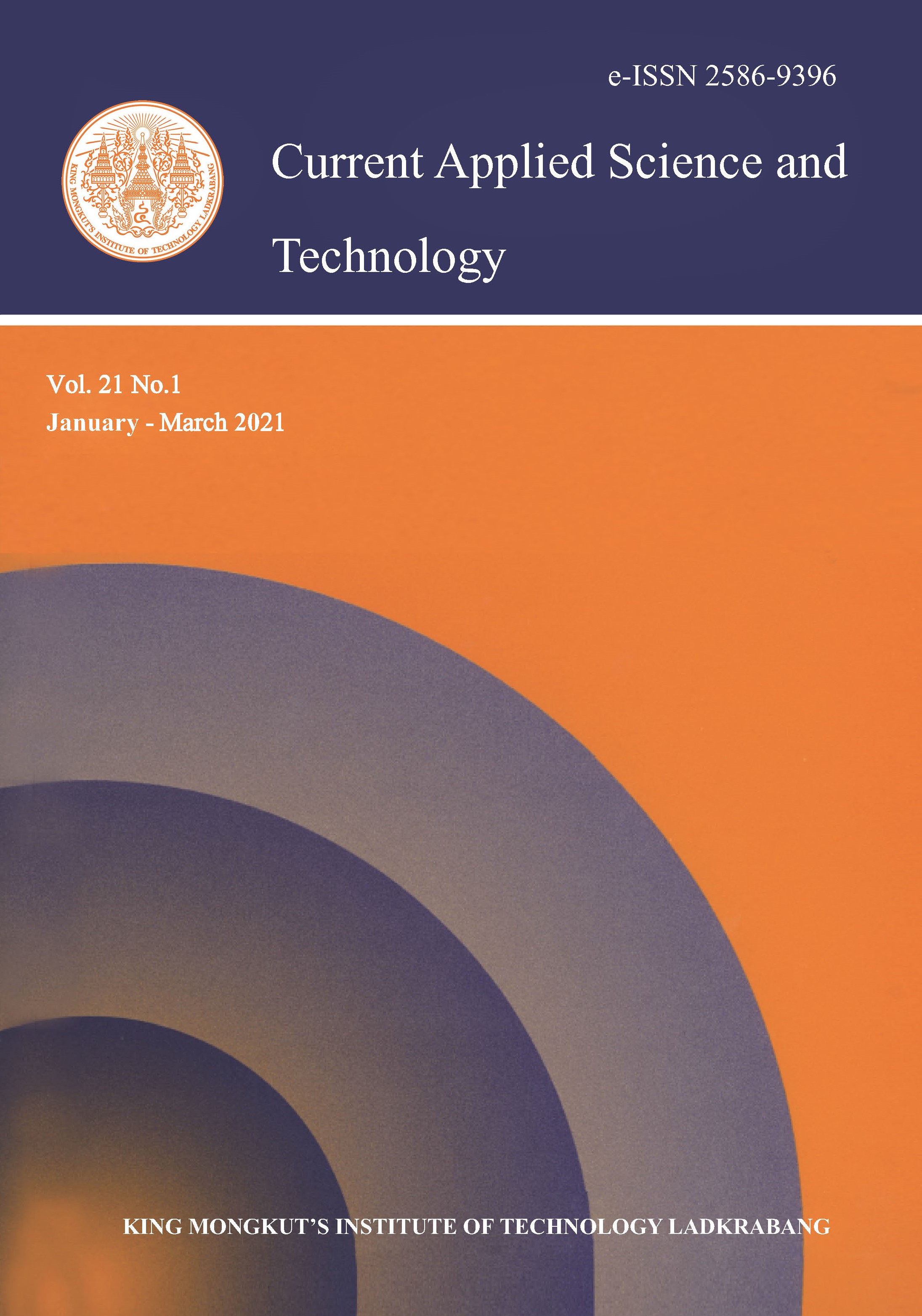Drying of Fluid Saturated Porous Materials by Electroosmosis
Main Article Content
Abstract
Electroosmosis is generated by the relative displacement of an electrolytic fluid with respect to solid surfaces under application of an electric field. The induced flow can assist in drying wet porous materials such as masonry used in buildings. In this work, the effectiveness of electroosmotic water transport induced by the application of a constant voltage across a wet porous sample is studied. A quantitative evaluation of water content is then performed at three different positions of the sample using a capacitive sensor. From the measured capacitance, the change of the dielectric constant of the wet sample over time is deduced. A model is then used to estimate the water content from the dielectric constant of the sample. It is seen that under application of constant voltages, the water content of the wet porous sample at the position close to the positive electrode decreases drastically. However, the water content remains almost constant in the middle of the sample and at a position close to the negative electrode. The reason is that water is pushed from the positive electrode to the negative electrode under application of electric field. Therefore, the water content becomes almost saturated right after applying a voltage across the sample. The results suggest that the electroosmotic technique can be applied to the drying of wet walls of buildings, and to stone and earth masonry structures, especially in cases where traditional techniques have not been able to solve the problems. Additionally, it is shown that our use of capacitive sensors is a technique that could be used to monitor the water content in wet porous materials.
Keywords: rising damp; capillary; masonry; electroosmosis
*Corresponding author: E-mail:thanh_lud@tlu.edu.vn
Article Details
Copyright Transfer Statement
The copyright of this article is transferred to Current Applied Science and Technology journal with effect if and when the article is accepted for publication. The copyright transfer covers the exclusive right to reproduce and distribute the article, including reprints, translations, photographic reproductions, electronic form (offline, online) or any other reproductions of similar nature.
The author warrants that this contribution is original and that he/she has full power to make this grant. The author signs for and accepts responsibility for releasing this material on behalf of any and all co-authors.
Here is the link for download: Copyright transfer form.pdf
References
Blocken, B. and Carmeliet, J., 2010. Overview of three state-of-the-art wind-driven rain assessment models and comparison based on model theory. Building and Environment, 45, 691-703.
Socoloski, R.F. and Masuero, A.B., 2019. Evaluation of the efficiency of the treatment for rising damp on walls through the insertion of chemical barriers by gravity. Construction and Building Materials, 210, 660-672.
Franzoni, E., 2014. Rising damp removal from historical masonries: A still open challenge. Construction and Building Materials, 54, 123-136.
Franzoni, E., 2018. State-of-the-art on methods for reducing rising damp in masonry. Journal of Cultural Heritage, 31(Supplement), S3-S9.
Salmon, D., Williams, R. and Tye, R., 2002.Thermal conductivity and moisture measurements on masonry materials. In: A. Desjarlais and R. Zarr, eds. Insulation Materials: Testing and Applications. Vol. 4. West Conshohocken: ASTM International, pp. 8-75.
Gentilini, C., Franzoni,E., Bandini,S. and Nobile, L., 2012. Effect of salt crystallisation on the shear behavior of masonry walls: an experimental study. Construction and Building Materials, 37, 181-189.
Bertolini, L., Coppola, L., Gastaldi, M. and Redaelli, E., 2009.Electroosmotic transport in porous construction materials and dehumidification of masonry. Construction and Building Materials, 23, 254-263.
Ottosen, L.M., and Rorig-Dalgaard, I., 2006. Drying brick masonry by electro-osmosis.Proceedings of the Seventh International Masonry Conference.British Masonry Society, London, U.K., 30 October-1 November, 2006. (CD-rom).
Ivliev, E.A., 2007. Electroosmotic drying of building walls and basements.Surface Engineering and Applied Electrochemistry, 43, 291-296.
Stanley, C., and Mcfeat-Smith, I., 2008. Electro-osmosis using multi pulse sequencing for removing and repelling water out of buildings and other structures.33rd Conference on Our World in Concrete and Structures,Singapore, 25-27 August, 2008.
Masliyah, J.H. and Bhattacharjee, S., 2006. Electrokinetic and Colloid Transport Phenomena.New Jersey: Wiley-Interscience.
Hunter, R.J., 1981.Zeta Potential in Colloid Science. New York: Academic Press.
Davis, J.A., James, R.O. and Leckie, J.O., 1978. Surface ionization and complexation at the oxide/water interface. I. computation of electrical double layer properties in simple electrolytes. Journal of Colloid and Interface Science, 63(3), 480-499.
Stern, O., 1924. Zur theorie der electrolytischen doppelschist. Z. Elektrochem, 30, 508-516.
Ishido, T. and Mizutani, H., 1981. Experimental and theoretical basis of electrokinetic phenomena in rock-water systems and its applications to geophysics. Journal of Geophysical Research, 86, 1763-1775.
Reuss, F., 1809. Sur un nouvel effet de l'lectricit galvanique. Mmoires de la SocietImperiale de Naturalistes de Moscou, 2, 327-336.
Gad-el-Hak, M., 2006. MEMS: Introduction and Fundamentals. 2nd ed. Boca Raton: Taylor and Francis.
Vu, H.T. and Tsotsas, E., 2018. Mass and heat transport models for analysis of the drying process in porous media: A review and numerical implementation. International Journal of Chemical Engineering, 2018, https://doi.org/10.1155/2018/9456418
Kaatze, U., 1997. The dielectric properties of water in its different states of interaction. Journal of Solution Chemistry, 26, 1049-1112.
Topp, G.C., Davis, J.L. and Annan, A.P., 1980. Electromagnetic determination of soil water content: Measurements in coaxial transmission lines. Water Resources Research, 16, 574-582.
Fen-Chong, T., Fabbri,A.,Guilbaud, J.P. and Coussy, O., 2004. Determination of liquid water content and dielectric constant in porous media by the capacitive method. Comptes Rendus Mecanique, 332, 639-645.
Thanh, L.D., Sprik, R. and Nguyen, X.C., 2019. Zeta potential of porous rocks in contact with mixtures of monovalent and divalent electrolytes. Geophysical Prospecting, 67, 1354-1368.
Harter, T., and Rollins, L., 2008.Watersheds, Groundwater and Drinking Water: A Practical Guide. California: University of California. Agriculture and Natural Resources Publications.
Vinogradov, J., Jaafar, M.Z. and Jackson, M.D., 2010. Measurement of streaming potential coupling coefficient in sandstones saturated with natural and artificial brines at high salinity. Journal of Geophysical Research, 115, https://doi.org/10.1029/2010JB007593


